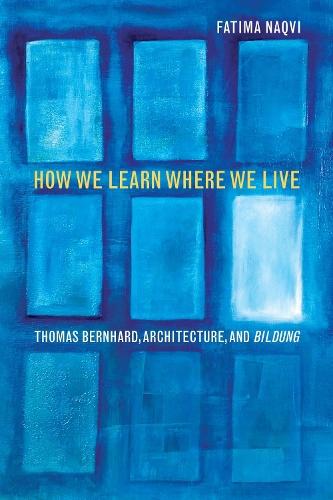Overview
In one of the first English studies of Thomas Bernhard, Fatima Naqvi focuses on the Austrian author’s critique of education (Bildung) through the edifices in which it takes place. His writings insist that learning has always been a life-long process that is helped—or hindered—by the particular buildings in which Bildung occurs. Naqvi offers close readings of Bernhard’s major prose works, from Amras (1964) to Old Masters (1985) and brings them into dialogue with major architectural debates of the times. She examines Bernhard’s interrogation of the theoretical foundations underpinning the educational system and its actual sites. How We Learn Where We Live opens new avenues into thinking about one of themost provocative writers of the twentieth century.
Full Product Details
Author: Fatima Naqvi
Publisher: Northwestern University Press
Imprint: Northwestern University Press
Dimensions:
Width: 15.20cm
, Height: 1.70cm
, Length: 22.60cm
Weight: 0.326kg
ISBN: 9780810132016
ISBN 10: 081013201
Pages: 256
Publication Date: 31 December 2015
Audience:
College/higher education
,
Professional and scholarly
,
Tertiary & Higher Education
,
Professional & Vocational
Format: Paperback
Publisher's Status: Active
Availability: In Print

This item will be ordered in for you from one of our suppliers. Upon receipt, we will promptly dispatch it out to you. For in store availability, please contact us.
Reviews
Fatima Naqvi's study fulfils a double function. It engages intensively with key narrative texts by Thomas Bernhard while offering a case study of the interaction between literature and architecture.... Naqvi makes clear beyond doubt that architecture is more than just a theme in these texts: it is fundamental to their structure. Bernhard's oeuvre is read against a wide variety of text-types and forms of knowledge: architecture manifestos, philosophical works (Bloch, Foucault, Heidegger, Wittgenstein), texts on the history of art and architecture. The resultant complex contextualisation raises scholarship on Bernhard's writings to a new level of reflection, and raises the bar for future research. --Austrian Studies -Fatima Naqvi's study fulfils a double function. It engages intensively with key narrative texts by Thomas Bernhard while offering a case study of the interaction between literature and architecture.... Naqvi makes clear beyond doubt that architecture is more than just a theme in these texts: it is fundamental to their structure. Bernhard's oeuvre is read against a wide variety of text-types and forms of knowledge: architecture manifestos, philosophical works (Bloch, Foucault, Heidegger, Wittgenstein), texts on the history of art and architecture. The resultant complex contextualisation raises scholarship on Bernhard's writings to a new level of reflection, and raises the bar for future research.- --Austrian Studies
The architectonics of Naqvi's mode of argumentation and analysis perform the porousness and openness that ultimately emerge as Bernhard's ideal space and model of education. --German Studies Review Fatima Naqvi's study fulfils a double function. It engages intensively with key narrative texts by Thomas Bernhard while offering a case study of the interaction between literature and architecture.... Naqvi makes clear beyond doubt that architecture is more than just a theme in these texts: it is fundamental to their structure. Bernhard's oeuvre is read against a wide variety of text-types and forms of knowledge: architecture manifestos, philosophical works (Bloch, Foucault, Heidegger, Wittgenstein), texts on the history of art and architecture. The resultant complex contextualisation raises scholarship on Bernhard's writings to a new level of reflection, and raises the bar for future research. --Austrian Studies
-Fatima Naqvi's study fulfils a double function. It engages intensively with key narrative texts by Thomas Bernhard while offering a case study of the interaction between literature and architecture.... Naqvi makes clear beyond doubt that architecture is more than just a theme in these texts: it is fundamental to their structure. Bernhard's oeuvre is read against a wide variety of text-types and forms of knowledge: architecture manifestos, philosophical works (Bloch, Foucault, Heidegger, Wittgenstein), texts on the history of art and architecture. The resultant complex contextualisation raises scholarship on Bernhard's writings to a new level of reflection, and raises the bar for future research.- --Austrian Studies
Author Information
Fatima Naqvi is a professor of German and film studies at Rutgers University, USA.




